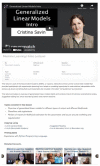Trainingspace: Neuroeducation Without Borders
- PMID: 38323044
- PMCID: PMC10653244
- DOI: 10.59390/BIWD8550
Trainingspace: Neuroeducation Without Borders
Abstract
Advancements in the field of neuroinformatics have resulted in a massive explosion of raw data of many varieties, yet many traditional neuroscience training programs have not changed their curricula to reflect the urgent need for improved computational skills that would enable trainees to handle, organize, and interrogate such large, multimodal datasets. Thus, the objective of this project was to build an open access hub of neuroscience educational resources to fill the gap between current neuroscience curricula and the computationally focused skillset required to work with big data. To achieve this aim, we invited representatives from the world's leading neuroscience societies and large-scale brain initiatives to form the INCF Training and Education Committee that would provide oversight over the content and capabilities of the online hub. As a result, we developed TrainingSpace (https://training.incf.org/), an open access hub of nearly 500 multimedia courses, lectures, and tool tutorials covering the subspecialisms of neuroscience and neuroinformatics, as well as computer science, data science, and ethics. In addition to course content, TrainingSpace also provides users with access to publicly available datasets through KnowledgeSpace, a discoverability portal and community encyclopedia for neuroscience, as well as a question and answer forum, Neurostars.org. Since its launch in 2019, TrainingSpace has steadily increased in popularity with both trainees and trainers alike. It has also become popular with content providers that want to make their training materials available to the neuroscience community-at-large, as well as integrate their content into the larger TrainingSpace ecosystem.
Keywords: computational neuroscience; conference lectures; courses; neuroethics; neuroinformatics; neuroscience; online training; open neuroscience resource; self-guided study; tutorials.
Copyright © 2022 Faculty for Undergraduate Neuroscience.
Figures




References
LinkOut - more resources
Full Text Sources
Research Materials
Miscellaneous
